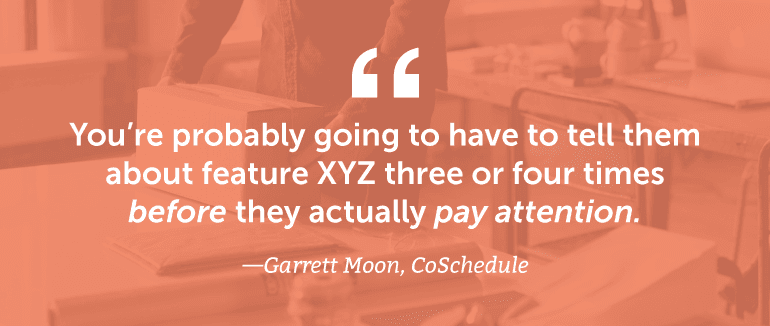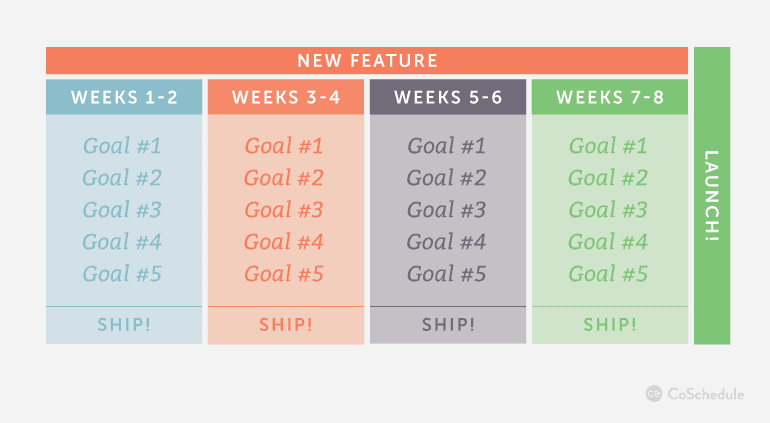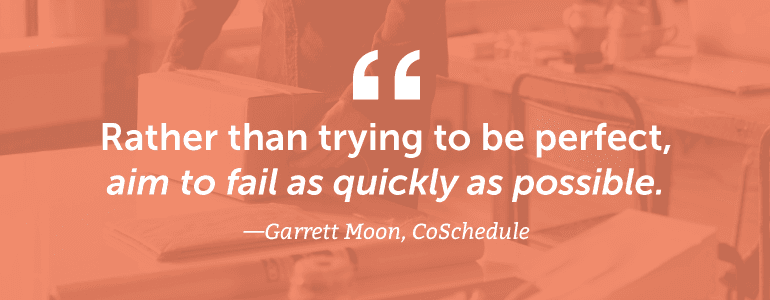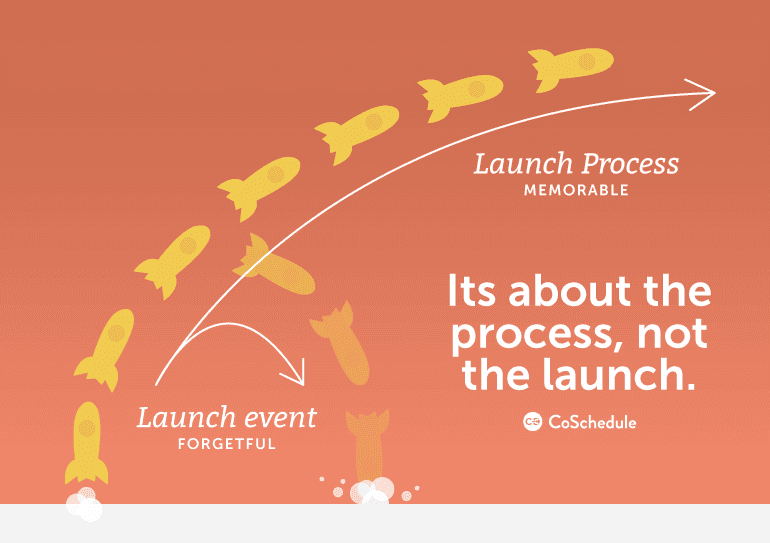How We Launched 4 Features in Less Than 6 Weeks with a Culture of Shipping
 Here at CoSchedule, we just completed a major sprint to launch four major new features in less than 6 weeks.
Whew.
It was a lot of fun.
https://twitter.com/garrett_moon/status/803656889384845312
In case you missed it, here’s what we launched. If you only want to learn how we did it, feel free to skip ahead.
Here at CoSchedule, we just completed a major sprint to launch four major new features in less than 6 weeks.
Whew.
It was a lot of fun.
https://twitter.com/garrett_moon/status/803656889384845312
In case you missed it, here’s what we launched. If you only want to learn how we did it, feel free to skip ahead.
- ReQueue is the most intelligent way to automate your social media. This is one of my favorite features ever, because it helps you make the most of the hard work you put into social media schedule. Now, CoSchedule will help you reuse to best social messages again when it sees a gap in your schedule. It’s the perfect social companion for the busiest of marketers.
- Instagram has quickly become one of the most important social networks for marketers and now you can schedule Instagram messages right from CoSchedule, along side the rest of your marketing strategy. Instagram publishing really makes CoSchedule the one-stop tools for your entire marketing strategy.
- Content UX included a major update to how content is managed on the CoSchedule calendar. While it included a massive design refresh, it also added a lot of functional changes around usability and user experience that make CoSchedule easier to use and collaborate with you team.
- Social Media Analytics helps our users prove the ROI of the work they do by eliminate the tedious process of gathering, analyzing, and reporting on your analytics. Now you can do it from one place with CoSchedule’s social message analytics and Social Engagement Reports.
 Long story short, that’s a lot of code to ship in short amount of time. So, how did we do it?
Long story short, that’s a lot of code to ship in short amount of time. So, how did we do it?
How A Culture Of Shipping Drives Our Work Ethic
Click To TweetBias for Action. We know that ideas don’t matter unless they become action. We always err on the side of shipping, failing fast, and getting better as we go along.But before we get too far, I want to let you in on our dirty little secret. We don’t launch 100% of our features all at once. Don’t get me wrong, these were great features, but they were the 1.0 version. This means that for every aspect of the feature we actually launched, there are between 3 and 4 major improvements that were left on the to do list. In general, I believe that the common concept of a “launch” is very misleading. Most of the time, we think of a launch as a singular event. We slave away for months in hiding while building something brand new. When it finally comes time to make it public we launch, and make a big splash. There are blog posts, tweets, press releases, and sometimes fanfare. And then it’s over. We move on to the next project and look forward to another “big launch.” But, that’s not really how things work. Your audience will never absorb your launch the way you expect them to. They’re busy and distracted. You’re probably going to have to tell them about feature XYZ three or four times before they actually pay attention.
 In short, launches shouldn’t be a singular event. They are just the beginning. They should really be just one singular step in an overall process of iteration.
In short, launches shouldn’t be a singular event. They are just the beginning. They should really be just one singular step in an overall process of iteration.
Launches should be one singular step in an overall process of iteration
Click To Tweet1. Wins Make for More Wins
When planning something new you are bound to develop big visions of excellence and grander. Take it easy cowboy/girl. Rather than trying to build the biggest and best right out of the gate, break your project into pieces. Think of it as a series of “launches” rather than one massive unveiling. Breaking projects down into tiny launch-able pieces will give you and your team some early wins. Wins can easily turn into momentum and momentum is exactly what fuels a culture of shipping. Around here, we like to break feature development into a series of 1-2 week projects—each one ending with a launch of some kind. We try not to focus on the whole enchilada. Rather, we focus on the smaller iterative goals that will need to be met in order to succeed. This ultra simple framework keeps us focused and motivated, and ultimately leads to the big win.
Wins make for more wins.
Click To Tweet2. We Assume that Our Customers Know More Than Us
When planning a new feature or launch, it can be easy to assume that you are the smartest person in the room. Work on a feature long enough and you’ll believe that no one understands it better than you. Unfortunately, you’ll probably be right. So, what if no one understands it but you? Feedback matters a lot. The world loves to emphasize the myth of the “lone genius” or the Steve Jobs personality in all of us. WRONG. There isn’t a such things as a lone genius in real life. In real life those geniuses had spouses, colleagues, or competitors that drove them and made them better. For a startup like CoSchedule, those drivers are our users. With every feature we launch, we try to leave a lot of room for customers to influence version 2.0. When a new feature goes live, our list of back burner items becomes irrelevant. From that point forward, customer feedback shapes version 2.0.There isn’t a such things as a lone genius in real life.
Click To Tweet3. We Focus on Failing Fast
Most of us try to avoid making mistakes. If we can’t avoid them, we at least try to make sure no one notices them when they happen. But, this reflex is in itself a mistake. Instead, the better approach is to assume that you will fail and build it right into your process. We call this failing fast. Rather than trying to be perfect, aim to fail as quickly as possible. If you’re building something new, show it to someone else as soon as you can. Even before you’re ready. Get feedback. Figure out what’s wrong The sooner you know what’s wrong, the sooner you can improve it, and that will help you move faster.
My background is in graphic design, and this can be a huge problem in that industry. Designers love to “move pixels” and make things perfect before showing their work to anyone. But, this is a mistake. It makes them slow and oftentimes damages the end result. Don’t assume you know it all. Assume that you will fail, and build it right into your process so that you know to expect it.
Rather than trying to be perfect, aim to fail as quickly as possible. If you’re building something new, show it to someone else as soon as you can. Even before you’re ready. Get feedback. Figure out what’s wrong The sooner you know what’s wrong, the sooner you can improve it, and that will help you move faster.
My background is in graphic design, and this can be a huge problem in that industry. Designers love to “move pixels” and make things perfect before showing their work to anyone. But, this is a mistake. It makes them slow and oftentimes damages the end result. Don’t assume you know it all. Assume that you will fail, and build it right into your process so that you know to expect it.
Assume that you will fail, and build it right into your process so that you know to expect it.
Click To Tweet4. We Keep Things Simple
Complicated features are bad for users (and for you). At CoSchedule, we’ve paid that price before. For example, the first version of ReQueue was overbuilt. Because we didn’t ship soon enough, the feature ended up getting too complicated and messy. When we gave it to a set of beta users and they were confused. They didn’t understand how to make the feature do what we said it could do. We ended up scrapping the entire project and building something different that was much simpler and more iterative. It was a lesson we don’t want to have to learn twice. Over time, we’ve learned to keep things as simple as possible. Sometime complex features are necessary, but it is better to iterate our way into them, rather than building it all at once.Stay iterative. Keep it simple. Ship on time! #aCultureOfShipping #OverheardAtCoSchedule
Click To Tweet5. Despite What You Believe, Launch Day Doesn’t Really Matter
I’ve already mentioned that launch day barely matters, but it bears repeating. Teams routinely put a lot of time into their big unveiling to find out that no one was really paying attention. The true art of the launching comes from realizing that launching is a process, not an event. It’s about the process of shipping, not just launching. From a marketing standpoint this means that we should be talking about new features for week and months after they launch. From a product standpoint this means that we should be building and perfecting a feature for months after they are live. This isn’t a one and done type of scenario.
We are so conditioned to believe that launch day is an event. We believe that our marketing is a narrative and that customers read every page, but they don’t. Marketing is messy. Shipping is messy. You’re better off with a process that embraces the mess than one that works against it.
From a marketing standpoint this means that we should be talking about new features for week and months after they launch. From a product standpoint this means that we should be building and perfecting a feature for months after they are live. This isn’t a one and done type of scenario.
We are so conditioned to believe that launch day is an event. We believe that our marketing is a narrative and that customers read every page, but they don’t. Marketing is messy. Shipping is messy. You’re better off with a process that embraces the mess than one that works against it.
Launching is messy. You’re better off with a process that just embraces it.
Click To Tweet


